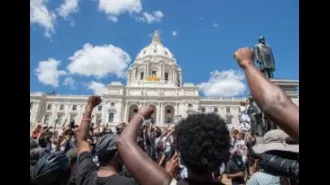Millions of devotees participate in the holy dip at Maha Kumbh Mela as the event comes to an end.
The Maha Kumbh Mela in Prayagraj ended with millions taking a holy dip on Maha Shivratri after 45 days of spiritual significance.
February 26th 2025.

The 45-day-long Maha Kumbh Mela, an event of great spiritual significance and one of the largest in the world, concluded on Wednesday in a grand spectacle at the Triveni Sangam in Prayagraj. Devotees from all over the world gathered for the final 'Amrit Snan' on the auspicious occasion of Maha Shivratri, adding to the already vibrant atmosphere with their chants of "Har Har Mahadev".
The event, which lasted over a month, saw a massive influx of over 1.32 crore pilgrims from all corners of India and beyond, who came to take part in the sacred ritual of bathing in the confluence of the Ganges, Yamuna, and Sarasvati rivers. As the sun rose on Maha Shivratri, the holy waters of the Sangam became a symbol of divine purification, and the devotees immersed themselves with the belief that this act would cleanse their souls and bring them blessings from Lord Shiva.
This year's Maha Kumbh Mela has broken all records, with over 65 crore people visiting Prayagraj during the 45-day event, making it one of the largest religious gatherings in the world. The festival has not only captured the hearts of devotees but has also received extensive international media coverage.
Publications like 'The Wall Street Journal' have highlighted the extraordinary number of participants, noting that the Kumbh Mela hosted more pilgrims than the entire population of the US. Meanwhile, 'CNN' provided in-depth coverage of the rituals, focusing on the presence of ash-smeared Naga Sadhus and the deeply rooted spiritual traditions observed at the Sangam.
However, with such a massive gathering, there were significant logistical challenges to be managed. The authorities rose to the occasion, ensuring seamless coordination and heightened security measures for the safety of the attendees. Police forces, paramilitary units, and disaster response teams worked tirelessly, aided by advanced technology such as AI-enabled cameras and surveillance drones to monitor the crowds in real-time. These efforts helped maintain order amidst the sea of people and ensured that the sacred rituals went on without interruption.
Managing the logistics of such a massive gathering required extensive preparation. To reduce congestion, a "no vehicle zone" was enforced in the Mela area and throughout Prayagraj. Special trains were arranged to transport pilgrims, and the North Eastern Railway deployed additional trains to handle the heavy rush of travelers. The Uttar Pradesh government worked closely with law enforcement agencies, disaster management forces, and medical teams to provide a safe environment for the devotees.
Uttar Pradesh Chief Minister Yogi Adityanath personally monitored the situation from the control room in Gorakhpur on the closing day, ensuring that everything ran smoothly as millions gathered to perform their sacred rituals. His efforts were complemented by an extensive security presence, including the deployment of police and paramilitary forces, who helped ensure the safety of the pilgrims while maintaining the sanctity of the event.
One of the most visually stunning moments of the closing day was the grand floral shower at the Sangam. In a traditional gesture of respect and reverence, 20 quintals of rose petals were showered on the devotees as they took their final dip. The sight of these delicate petals falling from the sky created a magical atmosphere, further enhancing the spiritual significance of the occasion. The petals, which covered the pilgrims in a blanket of fragrant beauty, symbolized divine blessings and the fulfillment of the devotees' wishes.
The rose petal shower was organized by the Uttar Pradesh government, led by Yogi Adityanath, as a way to honor the devotees who had participated in the final ritual of the Kumbh Mela. This gesture added a touch of grandeur and festivity to the concluding moments of the event, leaving everyone present with a sense of profound spiritual connection.
The Maha Kumbh Mela is more than just a religious event; it is a celebration of faith, unity, and the enduring spirit of devotion. Throughout the 45-day festival, pilgrims from all walks of life came together to participate in the sacred rituals, regardless of their background or status. The sight of millions of devotees, from different parts of India and the world, coming together to bathe in the holy waters of the Sangam serves as a testament to the power of spirituality to bring people together.
The festival's significance is not just in the religious rituals but also in its capacity to unite individuals across regional, cultural, and linguistic boundaries. As millions converged at the Sangam, they were reminded of their shared heritage and collective spiritual journey. The Maha Kumbh Mela thus stands as a symbol of India's rich spiritual tradition, one that continues to inspire people from all corners of the globe.
Over the course of the event, the Maha Kumbh Mela witnessed six key bathing dates, each marked by large gatherings of devotees participating in different aspects of the festival, from the sacred dips at the Sangam to prayer ceremonies at the temporary temples built for the occasion. The final day of the Kumbh, Maha Shivratri, was particularly significant, as it marked both the closing of the festival and the culmination of weeks of devotion. On this day, devotees offered prayers, performed rituals, and recited hymns in unison, reinforcing their devotion and spiritual resolve.
Though deeply rooted in Indian culture, the Maha Kumbh Mela has become a global event, attracting not only Indians but also people from all over the world. Pilgrims and tourists from countries like Nepal, Sri Lanka, and even distant places like the US, Russia, Italy, and Japan participated in the festivities, drawn by the sheer scale and unique spiritual experience offered by the festival.
For many, the Maha Kumbh Mela is not just a religious event but a life-changing experience—an opportunity to cleanse the soul, seek blessings, and connect with millions of others in a collective expression of faith. As the final 'Amrit Snan' on Maha Shivratri brought down the curtains on the 2025 Maha Kumbh Mela, the event left behind a lasting impact on all who participated. From the grand flower showers to the mesmerizing sight of pilgrims immersing themselves in the holy waters, this year's Maha Kumbh Mela will remain etched in the hearts of millions as a celebration of faith, unity, and divine blessings.
The event, which lasted over a month, saw a massive influx of over 1.32 crore pilgrims from all corners of India and beyond, who came to take part in the sacred ritual of bathing in the confluence of the Ganges, Yamuna, and Sarasvati rivers. As the sun rose on Maha Shivratri, the holy waters of the Sangam became a symbol of divine purification, and the devotees immersed themselves with the belief that this act would cleanse their souls and bring them blessings from Lord Shiva.
This year's Maha Kumbh Mela has broken all records, with over 65 crore people visiting Prayagraj during the 45-day event, making it one of the largest religious gatherings in the world. The festival has not only captured the hearts of devotees but has also received extensive international media coverage.
Publications like 'The Wall Street Journal' have highlighted the extraordinary number of participants, noting that the Kumbh Mela hosted more pilgrims than the entire population of the US. Meanwhile, 'CNN' provided in-depth coverage of the rituals, focusing on the presence of ash-smeared Naga Sadhus and the deeply rooted spiritual traditions observed at the Sangam.
However, with such a massive gathering, there were significant logistical challenges to be managed. The authorities rose to the occasion, ensuring seamless coordination and heightened security measures for the safety of the attendees. Police forces, paramilitary units, and disaster response teams worked tirelessly, aided by advanced technology such as AI-enabled cameras and surveillance drones to monitor the crowds in real-time. These efforts helped maintain order amidst the sea of people and ensured that the sacred rituals went on without interruption.
Managing the logistics of such a massive gathering required extensive preparation. To reduce congestion, a "no vehicle zone" was enforced in the Mela area and throughout Prayagraj. Special trains were arranged to transport pilgrims, and the North Eastern Railway deployed additional trains to handle the heavy rush of travelers. The Uttar Pradesh government worked closely with law enforcement agencies, disaster management forces, and medical teams to provide a safe environment for the devotees.
Uttar Pradesh Chief Minister Yogi Adityanath personally monitored the situation from the control room in Gorakhpur on the closing day, ensuring that everything ran smoothly as millions gathered to perform their sacred rituals. His efforts were complemented by an extensive security presence, including the deployment of police and paramilitary forces, who helped ensure the safety of the pilgrims while maintaining the sanctity of the event.
One of the most visually stunning moments of the closing day was the grand floral shower at the Sangam. In a traditional gesture of respect and reverence, 20 quintals of rose petals were showered on the devotees as they took their final dip. The sight of these delicate petals falling from the sky created a magical atmosphere, further enhancing the spiritual significance of the occasion. The petals, which covered the pilgrims in a blanket of fragrant beauty, symbolized divine blessings and the fulfillment of the devotees' wishes.
The rose petal shower was organized by the Uttar Pradesh government, led by Yogi Adityanath, as a way to honor the devotees who had participated in the final ritual of the Kumbh Mela. This gesture added a touch of grandeur and festivity to the concluding moments of the event, leaving everyone present with a sense of profound spiritual connection.
The Maha Kumbh Mela is more than just a religious event; it is a celebration of faith, unity, and the enduring spirit of devotion. Throughout the 45-day festival, pilgrims from all walks of life came together to participate in the sacred rituals, regardless of their background or status. The sight of millions of devotees, from different parts of India and the world, coming together to bathe in the holy waters of the Sangam serves as a testament to the power of spirituality to bring people together.
The festival's significance is not just in the religious rituals but also in its capacity to unite individuals across regional, cultural, and linguistic boundaries. As millions converged at the Sangam, they were reminded of their shared heritage and collective spiritual journey. The Maha Kumbh Mela thus stands as a symbol of India's rich spiritual tradition, one that continues to inspire people from all corners of the globe.
Over the course of the event, the Maha Kumbh Mela witnessed six key bathing dates, each marked by large gatherings of devotees participating in different aspects of the festival, from the sacred dips at the Sangam to prayer ceremonies at the temporary temples built for the occasion. The final day of the Kumbh, Maha Shivratri, was particularly significant, as it marked both the closing of the festival and the culmination of weeks of devotion. On this day, devotees offered prayers, performed rituals, and recited hymns in unison, reinforcing their devotion and spiritual resolve.
Though deeply rooted in Indian culture, the Maha Kumbh Mela has become a global event, attracting not only Indians but also people from all over the world. Pilgrims and tourists from countries like Nepal, Sri Lanka, and even distant places like the US, Russia, Italy, and Japan participated in the festivities, drawn by the sheer scale and unique spiritual experience offered by the festival.
For many, the Maha Kumbh Mela is not just a religious event but a life-changing experience—an opportunity to cleanse the soul, seek blessings, and connect with millions of others in a collective expression of faith. As the final 'Amrit Snan' on Maha Shivratri brought down the curtains on the 2025 Maha Kumbh Mela, the event left behind a lasting impact on all who participated. From the grand flower showers to the mesmerizing sight of pilgrims immersing themselves in the holy waters, this year's Maha Kumbh Mela will remain etched in the hearts of millions as a celebration of faith, unity, and divine blessings.
[This article has been trending online recently and has been generated with AI. Your feed is customized.]
[Generative AI is experimental.]
0
0
Submit Comment





